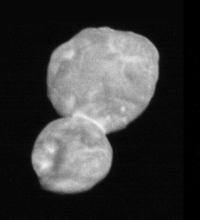Listen to today's episode of StarDate on the web the same day it airs in high-quality streaming audio without any extra ads or announcements. Choose a $8 one-month pass, or listen every day for a year for just $30.
You are here
Wispy Skies
Pluto is putting in its best appearance of the year. It was at “opposition” on Sunday night, lining up opposite the Sun in our sky. So it rises around sunset and is in view all night. It’s also closest to Earth for the year — more than three billion miles away. That means it shines brightest for the year, although you still need a good-sized telescope to see it. It’s easy to find Pluto’s location, though. It’s well to the lower left of the teapot outlined by Sagittarius.
Pluto is tiny — about two-thirds the diameter of the Moon. That means its gravity is weak. Yet it’s strong enough to hold onto a thin atmosphere — wisps of nitrogen, methane, and carbon monoxide.
The New Horizons spacecraft got a good look at the atmosphere when it flew past Pluto, in 2015. The atmosphere extended almost a thousand miles above the surface — a result of Pluto’s weak gravity. But the atmosphere is so cold that it doesn’t all escape into space. And it contains about 20 layers of haze, made of hydrocarbons and other heavy elements.
Backlit by the Sun, the atmosphere looks blue — and for the same reason that Earth’s air is blue: The nitrogen molecules scatter blue light, allowing redder wavelengths to shine through. From the surface of Pluto, though, you wouldn’t see much of that air. It’s no more than a hundred-thousandth as thick as Earth’s — a cold but thin blanket around far-away Pluto.
Tomorrow: “golden” stars.
Script by Damond Benningfield






